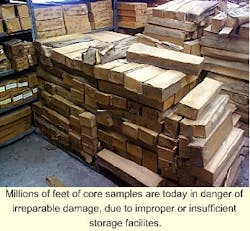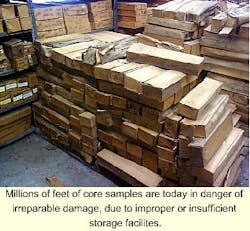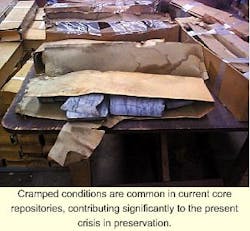In its day, the great library at Alexandria was known to hold "the memory of the world."
Built and maintained by the Ptolemaic kings of northern Egypt who came after Alexander the Great, the library sought to preserve works from many lands and languages. It became thereby an invaluable source of knowledge for scholars, rulers, military strategists, city builders, and many others. Loss of the collection by fire is aptly counted among the great tragedies of history.
The needs embodied by the great library have never changed. Building large collections of crucial source material has remained a way to ensure the vitality of knowledge in every conceivable discipline. To anyone engaged in a technical field, loss of access to this material would spell disaster.
We in the geosciences-and this includes petroleum geology, geophysics, and engineering alike-are blessed with another form of such material: rock itself. Outcrops, of course, offer many rewards, but for the petroleum professional samples from below ground are more critical. Drill cuttings and, above all, cores are the exposures of the subsurface. They are the only means to make the hydrocarbon reservoir visible and available to direct analysis.
Loss of such "exposures" is equivalent to the destruction of a book or document. This should require little elaboration: One need only consider the range of data routinely derived from a single whole-rock core and the role of such data in all levels of reservoir understanding, from facies analysis to reservoir simulation.
Each time a core sample is lost, thrown away, or damaged irreparably, the knowledge it bears is abandoned. Compounding this misfortune many times is equal to the destruction of an entire library.
Importance of cores: on the rise
Petroleum professionals sometimes assume that, in the contemporary era of 3D computer modeling, core data have a reduced importance. Nothing could be further from the truth. In fact, at least four reasons show why core samples are more important today.
First, major changes have taken place in the direction of the industry. As widely recognized, this is the age of field re-development and integrated reservoir characterization. Producers are faced with growing demands to optimize recovery through strategic infill drilling, re-completion, waterflooding, carbon dioxide flooding, and so forth. None of these approaches can be rationally planned or applied without a solid understanding of reservoir character, i.e. core data.
Second, sample data are now critical because of the rapid advances in geologic, geophysical, and engineering science that have accompanied the "computer revolution." These advances have imposed the need to re-examine and, at times, re-analyze existing samples in the light of new understanding. Sequence stratigraphy, seismic attribute analysis, geostatistical modeling, 3D reservoir simulation-all are recent innovations that would be impossible without both new and existing core data.
Third, one must consider the future in light of the past. Thanks to steady innovation in completion and EOR technology, field recoveries in much of the world have improved significantly. Nonetheless, in most cases fully 60-70% of potentially recoverable hydrocarbons remains in the ground. What the future will hold may be impossible to say precisely-except that advances will surely continue and they will depend, as they have in the past, on improved reservoir understanding. New analytical techniques and apparatus will evolve, in large part for this same reason. All of the above makes existing core samples an irreplaceable resource.
Finally, due to urban development, environmental restrictions, and other reasons, an increasing number of areas have been closed to future drilling. Core taken in the past from such areas thus attains a greatly added importance.
In sum, core samples acquire a growing value through time. This relates to increased importance as a central data source, the expanding range of analyses drawn from it, and also the high cost of coring itself. Truly, billions of dollars have been invested in coring over the past half century. What would it cost today to replace the samples that now exist? This is a sobering question, to be sure.
Core values: present situation
Why is any of this important? The answer is simple: rock samples are under a greater threat of being lost today, in huge volumes, than at any time in the past.
Two factors seem to conspire toward this situation. First, software-based E&P work has helped shift effort away from direct use of rock, even as such work remains reliant upon it. Workstation-based reservoir analysis generally demands core data but not core itself. The actual sample, therefore, once "stripped" of required information, tends to inspire disinterest.
A more serious reason behind the need for core preservation has to do with financial and organizational changes in the industry. On the one hand, cores are not cheap to maintain: a 1995 survey performed by Amoco at 11 major industry and private facilities indicated that costs then ran from $0.67 to $1.51 per box per year (average $1.16), with large companies holding up to several million boxes.1
On the other hand, the rapid pace of company buy-outs, mergers, property acquisitions, and divestitures has made for a great deal of uncertainty with respect to preserving and maintaining samples. Mergers have created "redundancy" in data, while divestitures have resulted in core changing hands multiple times over a few years. Add to this the short-term, chaotic cycle of massive layoffs and partial new hires, plus out-sourcing of many tasks, and it becomes predictable that much core ends up in some type of administrative or warehouse limbo. Finally, the strong shift in activity to the international arena has brought with it a certain devaluation in data and samples from US areas.
Historical perspective
Are these dangers for core preservation unique to the present moment? The answer is both yes and no.
As early as 1948, the American Association of Petroleum Geologists recognized that abundant samples "of fundamental scientific importance" were being lost and discarded at an alarming rate. AAPG therefore assembled a Committee on Preservation of Samples and Cores to examine the problem and offer recommendations.2 The major difficulty, the committee found, stemmed from a general lack of appreciation for both the near- and long-term value of sample material.3
By the early 1980s, things had reversed. A huge, expanding network of public repositories existed, with most still accepting new material. One source listed more than 100 repositories.4 A number of states by that time required samples from oil and gas tests. Many state facilities, moreover, were run without any user fees. This is not to mention, moreover, the growing number of private core facilities that came of age beginning in the late 1970s.
To a large degree, the decade between about 1975 and 1985 represented the peak era of core collection and preservation. What has taken place since is a steady decline, geared in part to industry conditions. Yet if the future is to hold new opportunities for improved scientific analysis of oil fields, and thus better recovery, preserving core samples must be viewed as a priority.
For these reasons, the AAPG Committee on Preservation of Cores and Samples was revitalized in 1995 and is again involved in analyzing conditions that threaten the survival of sample material. Committee members from both industry and government are working in collaboration with the American Geological Institute (AGI), which has itself launched a major effort to address the problem (see below). Early in the 1990s, AGI noted independently that "billions of dollars worth of domestic geological and geophysical data are in jeopardy of being lost or destroyed."
Two significant facts have emerged from recent studies by the AAPG Committee and AGI. A survey of articles in the AAPG Bulletin actually shows an increase in the direct use of core data during the past two decades, from an average of 38% of all articles in 1979-81 to 43% in 1996-98. At the same time, an AGI survey reveals that the number of public repositories has fallen to about 50-less than half the total in 1985. Taken together, these facts are indicators of the situation facing industry, academic, and government geoscientists today.
Repository realities
The question naturally arises: why don't companies simply donate their core to existing repositories, whether private or public? The problems here are two-fold and related. They have to do with cost and space.
Donating cores without any additional funding to help preserve and maintain them is tantamount to shifting the financial burden to the receiving facility. States, in particular, currently have scant resources to accept major volumes of new core, which would require building or renting new facilities.
At the same time, companies that might be interested in core philanthropy are usually in the midst of financial stress themselves and may not be able to contribute funds if the cost is viewed as high. Several private repositories that have raised fees in recent years have seen a significant decline in use.
On the other side, some significant donations have taken place. In 1994, Shell Oil donated its Midland, Tex., core facility, including 2.2 million linear ft of core and cuttings, to the University of Texas at Austin along with a $1.3 million endowment (equivalent to about $4/box). This would appear to offer an excellent model for future philanthropy. The problem, however, is that industry conditions today are not what they were 6 years ago. Few companies, including possibly Shell itself, feel they are now in a financial position to make cash donations at such a level.
The second problem is space. Even as they were being built and excellently maintained, the repositories of the 70s and early 80s were filling up due to the accelerated pace of drilling activity linked to the price boom. The surveys conducted by AGI and the AAPG Committee indicate that public facilities are now nearing capacity.
AGI estimates that as much as 3-4 million ft of core is on the verge of being discarded unless space can be found to save it. By comparison, the US Geological Survey core facility in Denver and the Core Research Center (CRC) of the Texas Bureau of Economic Geology in Austin, two of the largest public repositories in the US, each hold about 1.4 million ft.
The Denver facility cannot presently accept volumes of new core without disposing of old samples, and the CRC is estimated to be 85-90% full. These facilities summarize the larger circumstance faced by public repositories in general. On the private side, the large core facility in Schulenburg, Tex., has nearly as much footage and can still accept more but is mainly regional in its holdings and obviously cannot accept the volumes of core that AGI estimates are immediately threatened.
What can be done?
What steps might be taken to save the great number of samples now being threatened?
AGI and the AAPG Committee have come up with ideas that seem innovative and workable. On the one hand, with the support of the US Department of Energy and portions of the industry, AGI has investigated archiving and preserving data in existing repositories. Though necessary, this is not sufficient, for all the reasons given above.
Instead, AGI and AAPG propose the creation of a centralized repository, a Library of Congress for samples that would be in the public domain. Such a repository, in fact, would form a major part of an even larger collection of geoscience data that would include seismic, well log, geochemical, thin section, scout ticket, and other important data also in danger of extinction. AGI has vigorously pursued this idea. Beginning in 1994, AGI began to study the feasibility of establishing just such a National Geoscience Data Repository System.5 6
Discussions with petroleum and minerals companies since then have indicated a willingness on the part of operators to consider donating truly vast amounts of data (Table 1). This volume totals perhaps 25% of all land seismic data collected in the US since 1950 and over 50% of all cores and cuttings held by major oil and gas companies.7
The concept is at once magnificent and daunting. Clearly, it arrives at exactly the right moment, and it has obviously captured the imagination of companies participating in the AGI studies to this point. But it continues to face significant hurdles. On the one hand, the NGDRS has had success in creating a software data catalog and access system called GeoTrek, now available with limited offerings via the world-wide web (http://www.agiweb.org/ NGDRS/). Still in its infancy, GeoTrek promises to be a useful tool, yet its ultimate utility will obviously depend on whether an actual physical facility can be found to house the repository. Company willingness to donate material is itself largely contingent upon such a repository being located.
The crucial step is therefore to find a site for the NGDRS collection. This may require patience and perseverence. AGI estimates that, for samples, a separate facility with 250,000-300,000 sq ft able to hold 35-ft-high racks will be needed. To adequately set up, maintain, and guarantee such a repository for the long-term, meanwhile, an endowment of about $10 million would be necessary. Recently, AGI identified an unused hangar at Denver's Stapleton International Airport, with 250,000 sq ft, as a possible choice. However, expensive repairs ($2-3 million) and environment liabilities make this option unfeasible for the moment.
Other potential facilities must surely exist and need to be pursued. The idea of using several regional repositories has been considered and would obviously entail a greater expense overall. Either way, however, the time to embark on a search for such facilities is now.
Conclusion
Libraries and human beings share many of the same enemies. War, fire, physical damage, neglect: these are among the forces that reduce the dimensions of life and knowledge. We in the geosciences appear poised to lose large portions of an irreplaceable intellectual legacy. The reasons responsible for this situation, tied as they are to change and turmoil within the energy industry, argue strongly for a new type of "great library" to counter the threat of loss.
Cores have always been expensive to acquire. Advances in knowledge and technology have guaranteed that the reasons for acquiring them not only persist but have intensified. There is a decided need for finding ways to save the intellectual and economic capital invested in the subsurface legacy that has come to exist. Allowing such capital to vanish is tantamount to impoverishing the future.
Too often in history, scholars and scientists have been forced to witness the destruction of their libraries. Every time core is lost, it means both data and dollars burned. Now, perhaps, is the time to find opportunities to do the opposite. We geoscientists should be become involved and supportive both to find a solution to the larger storage problem and to continue to serve as stewards for the material we may have at hand.
References
- Thomas, D.C., "Amoco core and geoscience sample management study," internal report, 1995, 17 p.
The Author
Scott L. Montgomery is a Seattle petroleum consultant and author. He is lead author of the "E&P Notes" series in the AAPG Bulletin. He holds a BA degree in English from Knox College and an MS degree in geological sciences from Cornell University. E-mail: [email protected]






